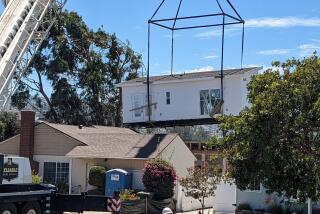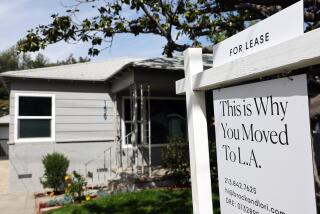A 5th for Low-Income : Council Agrees to Subsidies for 60 Sun Valley Units
With a rare display of unity by San Fernando Valley representatives on the question of low-income housing, the Los Angeles City Council on Friday voted to subsidize 60 Sun Valley apartment units, one-fifth of which will be reserved for low-income residents.
It was one of only a handful of low-income projects approved for the northeast Valley in the last five years.
Since 1981, most such projects have been blocked by Councilman Howard Finn on grounds that they were “so isolated from parks and transportation they would be like a prison,” as he said Friday.
The Sun Valley project also was one of a handful in recent years that escaped attack by Councilman Ernani Bernardi, who represents the central Valley and who has for years opposed most subsidized housing proposals on the grounds they are too expensive and a waste of tax dollars.
Bernardi said the Sun Valley project was “not so plush, so I didn’t try to knock it down.”
Both Have Subsidized Housing
Finn, who represents the northeast Valley, and Bernardi between them represent most of the Valley’s low-income residents and have the bulk of the Valley’s subsidized housing in their districts.
In an interview, Finn said that, although subsidized housing is “very much needed” in his 1st District, he has rejected at least three such projects because they were too remote from government services.
The councilman added: “And there probably were more that never got so far along as to be brought to me because the developers found out that I had sent out a strong message on this issue.”
Finn said the project approved Friday, in the 11000 block of Arminta Street, “is situated nicely so that residents will have access to essential public services.”
The council unanimously approved shifting $630,000 from the proceeds of the city’s Bunker Hill Redevelopment Project in downtown Los Angeles to underwrite the Sun Valley project.
In return for the subsidy, city officials said, developer Kurken Alyanak has agreed to rent 12 units at below-market rates to residents with annual incomes below $16,900 for a single person and below $24,150 for a family of four.
State law requires that, at a minimum, each low-income housing unit displaced by a redevelopment project be replaced by another unit somewhere in the city. About 1,000 units subsidized with redevelopment funds are available to low-income residents in the city.
Cites Comparative Costs
Bernardi said that the $70,000-per-unit cost for the Sun Valley project “is still too high when private industry can bring these in at $50,000 or $60,000, but it wasn’t as outrageous as some have been.”
Bernardi said that, unlike Finn, he has never rejected a project for his district because it was too distant from city services.
“There is a terrible need for low-income housing,” he said, “and, if it’s built, people will get to it and will get to and from services. My only beef is the way they overbuild and waste money on these things.”
Although such projects come before the full council for approval, the council traditionally defers to the wishes of a council member regarding subsidized housing for his or her district.
In Bernardi’s district, there are 29 subsidized projects with about 170 units reserved for low-income residents, said Jay Melnick, the councilman’s aide.
Greg Jackson, Finn’s legislative aide, said that, in the 1st District, there are 45 subsidized projects. But he could not immediately say how many units are reserved for low-income residents.
In both districts, most of the subsidized units were underwritten by the city’s sale of tax-exempt bonds rather than redevelopment funds.
More to Read
Sign up for Essential California
The most important California stories and recommendations in your inbox every morning.
You may occasionally receive promotional content from the Los Angeles Times.






